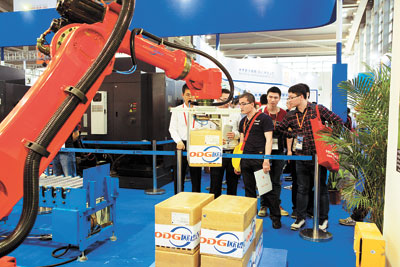
THESE are difficult days to be a factory owner in China. Workers are increasingly scarce, wages are rising, and strikes are breaking out with regularity.
Factories in southeast Asia are now beating China at its own game, attracting investors with the promise of even cheaper labor for low-value assembly work. What’s a factory owner to do?
One increasingly popular option is to buy robots, lots of them. But that solution is already raising another uncomfortable question: what to do with the workers they displace?
According to the International Federation of Robotics, an association of academic and business robotics organizations, China bought approximately 56,000 of the 227,000 industrial robots purchased worldwide in 2014 — a 54 percent increase on 2013. And in all likelihood, China is just getting started.
Late last month, the government of Guangdong Province, the heart of China’s manufacturing behemoth, announced a three-year program to subsidize the purchase of robots at nearly 2,000 of the province’s — and thus, the world’s — largest manufacturers. Guangzhou, the provincial capital, aims to have 80 percent of its factories automated by 2020.
The government’s involvement in this process shouldn’t come as a surprise. The Chinese Government has long wanted to shift the country’s manufacturing away from low-quality products that are manually assembled and toward higher-value ones — like automobiles, household appliances, and higher-end consumer electronics — that require the precision of automation.
And it’s no secret that demographics aren’t on the side of China’s traditional, labor-driven factories.
Urbanization, population control policies, and cultural shifts have pushed China’s average birth rate below those in more developed countries like the United States. Meanwhile, as a result of growing urban affluence, workforce participation rates are in decline, especially among women. Together, these factors are pushing wages upward, with an average annual increase of 12 percent since 2001. That trend offers plenty of incentive to factory owners and government officials to pursue automation.
Of course, what looks sensible from the perspective of the economic planner’s office is more distressing from the factory floor.
In March, Caixin, a Chinese business magazine, reported that Midea, a major Chinese manufacturer of air-conditioners and other appliances, plans to cut 6,000 of its 30,000 workers in 2015 to make way for automation. By 2018, it will cut another 4,000.
What will happen to those and the millions of other low skill workers who will be displaced by the shift?
The answers offered so far by companies and government officials haven’t been very reassuring.
Meanwhile, officials in Guangdong Province and their supporters in the Chinese media argue that the government-subsidized robotics industry will provide plenty of employment opportunities in robot manufacturing.
But even if displaced low-skilled workers can be funneled into those jobs as rapidly as the Chinese Government suggests, there’s no guarantee that the resulting jobs will pay as well as those they replace.
In fact, with so many displaced workers seeking to fill them, they might even pay less, according to a recent study of automation’s impact on labor markets.
(SD-Agencies)
|

